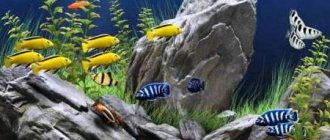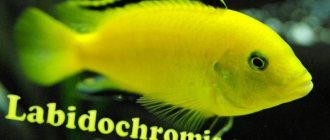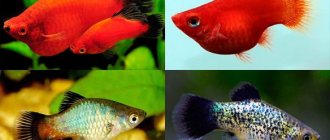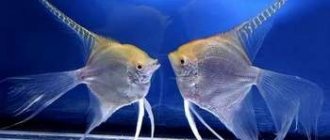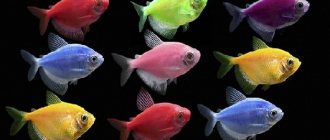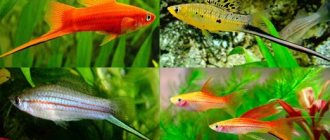Cichlids are loved by home aquarium owners for their diversity of species, bright colors and unusual habits. This is the only fish capable of recognizing its owner and carefully caring for its offspring.
In addition, family values are not alien to her, because this fish chooses a partner for life. Cichlids can breed in an aquarium and live quite a long time.
Cichlids
The Cichlid family includes up to 3,000 species, which are distributed throughout the world. Almost half of them live in lakes and rivers of Africa, but colorful fish are also found in the warm rivers of South America and Asia.
They began to breed exotic pets in artificial reservoirs since the times of ancient Egypt, but in Russia and Europe they appeared only in the 20th century, they fell in love with lovers and breeders, who began to breed original and beautifully colored breeds, choosing the most peaceful species.
Cichlids in nature live in fresh or slightly salty lakes and rivers. They belong to the family of ray-tailed fish, the order of perciformes, and have sizes from 2.5 cm to a meter. The main part of Cichlids has a tall body, slightly flattened, with a large head. The commercial breed Tilapia belongs to the same family. The lifespan of fish reaches 10-15 years in an aquarium, in nature up to 20-25 years.
Table of basic parameters of maintenance, care and nutrition:
| What should be the volume of an aquarium for Cichlids? | from 150-300 liters |
| What should be the temperature in the aquarium for Cichlids? | from +20-28 °C |
| What pH should be in the aquarium? | from 6-8 pH |
| What should be the hardness of the water in the aquarium? | from 5-15° dH |
| What should be the substrate for an aquarium? | any |
| What kind of lighting should be in the aquarium? | moderate |
| What should be the movement of water in the aquarium? | moderate |
| Maximum fish size | from 2.5 cm to a meter (depending on the type) |
| What does aquarium fish eat? | depends on the type: aquarium plants; dry food; live food: daphnia, tubifex, bloodworms |
| Type of aquarium fish | aggressive |
| Who is compatible with in an aquarium? | get along with all non-aggressive fish species that do not fit in the mouth |
| Lifespan | up to 10-15 years |
Aquarium fish Cichlids: maintenance and care
Breeders have bred a large number of species of Cichlids, differing from each other in appearance, body shape and habits. Fish can be painted in a wide variety of colors: white, pearlescent, blue, green, pink. Different species have their own patterns on the sides: longitudinal or transverse stripes, specks, dots. The body shape of different species is different: elongated, circular, flat. The character of the fish is also not the same; they can be quarrelsome and peaceful.
Caring for Cichlids is not too complicated, but it requires following some rules:
- the volume of the aquarium should be from 150-300 liters;
- be sure to provide grottoes, caves, houses so that the fish can hide;
- make sure that the constant water temperature is +20-28° C, but for some species the temperature can be from +28-30° C;
- acidity 6-8 pH;
- hardness from 5-15° dH;
- the water must be clean, partial replacement is necessary 2 times a week, the water should not be too hard;
- filter water, install an aeration system;
- It is better to make the aquarium a species one by placing a family of one male and several females there. You should not put several males of the same species into one aquarium; they will destroy each other.
You should not plant aquarium plants in the tank, the fish will tear them to pieces. It is worth giving preference to artificial bushes; it is better to pour sand on the bottom. A lid with artificial lighting should be installed on top; the light should be diffused and not too bright.
What to feed cichlids
It is important to feed this breed of fish correctly. First of all, you should study what type of food is suitable for a given species, carnivorous, herbivorous or omnivorous. You cannot feed Cichlids only with dry food; the fish need live food.
Herbivorous species happily eat chopped lettuce, spinach, and dandelion; they will not refuse vegetables: cucumber, zucchini, carrots.
Predators need live food, that is, protein food: live bloodworms, cortera, chopped squid, fish, grated beef heart or liver. Omnivorous species consume 30% protein foods, 70% plant foods.
What to feed the fry
The fry that have just emerged from the eggs are fed with ciliates, daphnia, sedge; when they grow up, they are fed with daphnia, live crushed bloodworms, and ready-made food.
If they don't finish eating
If the fish do not finish their food during feeding, there are two possible reasons:
But in any case, the first step is to remove the remaining food particles. Otherwise, they will fall into the substrate and begin to rot and decompose. If it is a protein food, then nitrogenous bases will be released, leading to poisoning of the inhabitants.
How to distinguish a male from a female and their reproduction in an aquarium
Male Cichlids usually have more pronounced colors and are slightly larger than females, but there are breeds in which the females are larger.
With the onset of maturity, males develop a fatty growth on the head in most species, which does not occur in females. Males often have a dark spot on their sides. Pisces are very constant, choosing one partner for themselves.
Various species of Cichlids reproduce well in an aquarium if the proper conditions are maintained. It is better to place the pair in a separate container for the spawning period, provide dim lighting and the desired temperature depending on the species, and do not disturb the fish at this time.
Of all aquatic inhabitants, these fish are the most caring parents. Cichlids dig a hole in the sand or choose a place on a stone, on leaves in a secluded place, lay eggs, fertilize them and protect them from other inhabitants of the aquarium. By moving their fins, the parents create water circulation over the clutch. They remove dead eggs and monitor the condition of the eggs. A litter can reach 2,000 eggs, but not all survive.
African breeds tend to hold the eggs in their mouths to ensure the safety of their offspring. These breeds can have up to 100 eggs. During the ripening period of eggs, they refuse food.
The newly hatched fry stay in a school just below their parents or one of the parents, so the fry feel safe.
Description
Despite such wide species diversity, all cichlids have a number of common features. They have an oblong body along which the upper fin stretches, a large head with full lips, and hard anterior rays on the fins. All cichlids have bright colors, especially during the breeding season. The cichlid is a predator, a fish with character, it protects its territory and is constantly busy with something. It is for their character that aquarists love them so much.
Cichlids compatibility with other fish
Before getting fish of this breed, you should study the issue of Cichlid compatibility with other inhabitants of the aquarium. It is better to keep them separately, as they have a difficult character and can be aggressive.
Acara, Discus, and Angelfish have the most peaceful disposition. Cichlids get along well with Swordtails, Mellinesia, Gouramis, Danios, and catfish. These breeds live their own lives and do not offend other inhabitants of the aquarium.
Granules
Food for cichlids in the form of granules comes in two types. For herbivorous fish and predators. They differ primarily in composition. We will not focus on this, because we have already said above.
Granules (also called balls), whose color is green-brown, are created for herbivorous cichlid fish. One half of such a granule is green, the second is light brown. Red-brown granules, respectively, are suitable for omnivorous and carnivorous pets.
Cichlid species
These fish are so diverse that it is sometimes difficult to recognize them as relatives. Cichlids are divided into 3 classes:
- South American class, fish prefer soft water;
- African class, its representatives can live in water of medium hardness;
- The Asian class is the smallest and is distinguished by behavioral characteristics.
Here are some of the types:
Akara turquoise
A representative of the South American class is the turquoise Acara, brought to Europe in the 20th century. This small fish is quite peaceful, but predatory. In an aquarium it reaches 25-30 cm, has greenish-blue scales with dark markings on the body and a yellow color on the tips of the fins.
Feeds on all types of live and frozen fish food. You can also make minced beef liver or heart.
The male reaches maturity only when he has a fatty seal on his head - this is around 6 months. Water temperature from +20-26° C, acidity from 6-8 pH, hardness from 5-13° dH. Life span is 8-10 years.
Angelfish
Angelfish have been living in aquariums since the beginning of the 20th century; their bodies are tall and crescent-shaped with long, voluminous fins. In nature, they are white with black transverse stripes, but breeders have developed many different colors of fish. Angelfish are calm, easy to care for, and get along well with other aquarium inhabitants that do not fit into their mouths.
It feeds on specialized dry, live and frozen food: bloodworms, adult brine shrimp, coretra, tubifex.
The size of the angelfish is up to 15 cm in length, height 26-30 cm. Aquarium size from 100 liters, water temperature + 22-28 ° C with acidity from 5-7 pH and hardness up to 10 ° dH. They live up to 10 years.
Maingano
The Maingano cichlid is from the African class, grows up to 10 cm. This is a schooling fish that requires an aquarium of at least 120 liters in size.
In the wild they feed on plants and living organisms. You can also balance the diet in the aquarium. Feed dry, frozen and live food 2 times a day. After 5 minutes, if there is food left, it must be removed from the aquarium.
Water temperature from +23 to 28° C with average hardness 10-18° dH, pH level 7-8. Life expectancy is up to 9 years.
Discus
Discus fish, which have a tall, round body, are considered an elite breed. Many different colored species of this breed have been bred: red, yellow, white, pink. They are quite finicky to care for.
African breeds are distinguished by their variety of colors and high intelligence. They are the ones who are able to recognize the owner and feel affection for people. They grow from 15-25 cm in length. These fish live in an aquarium of 50 liters per individual. Water temperature from +28-30° C, acidity from 6-8.5 pH, hardness up to 15° dH. Life span more than 10 years.
You need to feed 2-3 times a day with dry, live, frozen food - a balanced diet.
Parrot
The most common African species are the Parrot Cichlid, ranging in size from 10-30 cm (depending on the species), the fish is bright and beautiful, but quite aggressive.
It eats everything that is given: dry, live, frozen food. You can also periodically give vegetables that need to be boiled for 5 minutes (for example, zucchini). Proper feeding is a balanced diet.
You need to keep a flock of 3-4 individuals in an aquarium of 90 liters or more, but this depends on the size of the Parrot fish. If the size of the fish is 30 cm, then the aquarium needs from 200 liters. Water temperature from +24-27° C, acidity from 6.5-7.5 pH, hardness up to 12° dH. Lives up to 5 years.
In addition, Frontosa, Princess of Burundi and other breeds are popular.
Diseases: symptoms and treatment
With proper care and good feeding, Cichlids rarely get sick; they are naturally endowed with good health. Changes in living conditions and stressful situations can weaken their natural immunity and lead to illness. Hypothermia, the presence of chlorine, excessive water hardness, and poor nutrition have a negative impact on the health of fish.
Most often they suffer from ichthyophthoriosis, caused by a parasitic ciliate. At the same time, the fins can dry out and become deformed, the fish scratches itself on objects and becomes restless. The treatment is simple: place the fish in salted water (10 g per liter of water) for a few minutes, repeat if necessary. It is important to treat all the inhabitants of the aquarium and then refresh the water.
Sometimes the Saprolegniosis fungus appears, looking like a piece of cotton wool or a clot of foam. In this case, a course of treatment with bicellin is necessary.
Fish will remain healthy for many years if you care for them properly!
What food is best to buy?
Take Tetra food - you won't go wrong. It is produced in Germany, the quality is excellent. Perhaps some will find it expensive. For large fish, you can immediately take a large bucket. For small ones, a liter jar will be enough.
And one more secret: there is Tetra food that is sold by weight. They can hardly be ordered online. And in pet stores that have an aquarium department, they will always be there. They are usually packaged in ten, twenty and fifty gram bags. And such prepackaged food is much cheaper than packaged food in a jar. A brand costs money, don’t forget that.
Sera also produces good food. This is also a German company. It has proven itself well among amateur aquarists.
